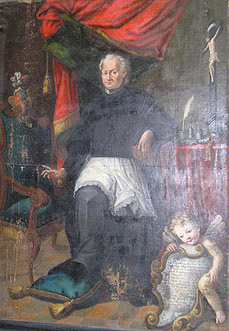The piece of the month of September 2006
A PORTRAIT OF AN ILLUSTRIOUS NAVARRESE IN THE CATHEDRAL: DON JUAN MIGUEL MORTELA Y CIGANDA, ARCHDEACON OF BERBERIEGO IN THE CATHEDRAL OF CALAHORRA.
Ricardo Fernández Gracia
Chair of Navarrese Heritage and Art
The Navarrese canon Juan Miguel Mortela, is emerging as a major figure in the development of the numerous artistic works made in the cathedral of Calahorra between 1730 and 1770. According to his own statement, the income he received for his ecclesiastical posts, which were not few and succulent, -arcedian of Berberiego, canon of Calagurritano, diocesan vicar, subcollector of spolios, vacancies and ecclesiastical half annatas and prior of Falces- he dedicated to the increase of divine worship and adornment of the cathedral of Calahorra and the parish churches of Lumbier and Falces. With his personal income he acquired numerous lands in Navarre and established an entailed estate in favor of his relatives in Lumbier, where he paid for a large house.
He was born in Sorauren in 1687. We do not know where he studied, nor hardly anything about his meteoric degree program. Undoubtedly the contact with important personalities and outstanding environments, led him to his fondness for the fine arts and, particularly, for painting. At an unknown date, he was ordained a priest in the diocese of Pamplona, and later became secretary to the bishop of Calahorra, José Espejo. He was named canon of Calahorra and archdeacon of Berberiego, dignity of that cathedral, in 1724. He also enjoyed a benefice in the parish of Badostain and, in 1738, he was designated, with the consent of the Marquis of Falces, prior of his parish. His trips to Madrid are documented, at least since 1729, when he obtained some Dimisoriales from his prelate Don José Espejo y Cisneros, bishop of Calahorra, knight of Santiago and lord of the town of Arnedillo, addressed to the primate of Toledo, in view of the need that Mortela had to go to the capital of Spain and other parts of the archbishopric of Toledo. In 1752, at the request of the Marquis de la Ensenada, he returned to the Villa y Corte, as we will see later, when dealing with the image of the Immaculate Conception that he gave as a gift to be the head of the altarpiece and chapel where he himself would be buried.
Gutiérrez Pastor gives us an account of his splendid collection of paintings, enriched with paintings that he himself acquired and others that the Calagurritan chapter gave him, as award for his efforts in the cathedral works, including works by Escalante, Rafael, Ribera, Cotto, Maratta, Murillo and Palomino. Ana Jesús Mateos has dealt with his multiple work as promoter, supervisor or patron of the Calaguritanian cathedral. The documentation we have left of works such as the altarpiece of the Immaculate Conception or the altarpiece of the Martyrs or of the trascoro and of those who took part in those projects is, to say the least, surprising, due to the amount of data it provides us with. Regarding the parish church of Falces, rebuilt in his time, there are no programs of study that tell us about his work, although we do know that his intervention in the awarding of the collateral altarpieces to Juan Tornes was decisive. It is very possible that the decoration carried out in the sacristy of Falces by the Aragonese Francisco del Plano, in 1738, over a period of one hundred and thirteen days, was due to Mortela's own indication, taking into account that the aforementioned painter had just completed the decorative program in tempera of the sacristy of the cathedral of Calahorra, under his strict supervision.
In Lumbier he paid for the estate he founded in the Navarrese town of Lumbier. The new house, known as the Antillón house, was one of the most interesting buildings in the town, whose construction accounts in the third quarter of the 18th century have been preserved in their entirety. The Benedictine nuns of Lumbier, today in Alzuza, preserve the famous painting of the Immaculate Conception by the Cordovan painter Juan Antonio Frías Escalante, signed in 1666, which belonged to Mortela and was donated by the daughters of Don Benito Antillón to the nuns in 1840.

Portrait of Don Juan Miguel Mortela. Pamplona Cathedral
His portrait is preserved in the cathedral of Pamplona. Possibly it comes from the house of his entailed estate in Lumbier or it was a gift to some capitular of Pamplona in other times. Most probably it is a bequest to the cathedral of the Antillón sisters who owned the Mortela entailed estate in the 19th century, since other paintings in the cathedral of Pamplona have some registration allusive to the aforementioned sisters. The large canvas has a beautiful cartouche and a registration inside it, where their main positions and the date and place of birth are listed.
bibliography
GUTIERREZ PASTOR, I,: "Don Juan Miguel Mortela and the origin of the Immaculate of Escalante in the Benedictine Sisters of Lumbier". conference proceedings of the I General congress of History of Navarre. Vol. VI. Príncipe de Viana (1988) Annex 11, pp. 229-234.
MATEOS GIL, A.J.: "The artistic influence of Juan Miguel Mortela in the cathedral of Calahorra". Kalakorikos (1996), pp. 69-84.
FERNÁNDEZ GRACIA, R.: The Immaculate Conception in Navarre. Art and devotion during the centuries of the Baroque. Pamplona, Eunsa, 2004, pp. 299-308.
